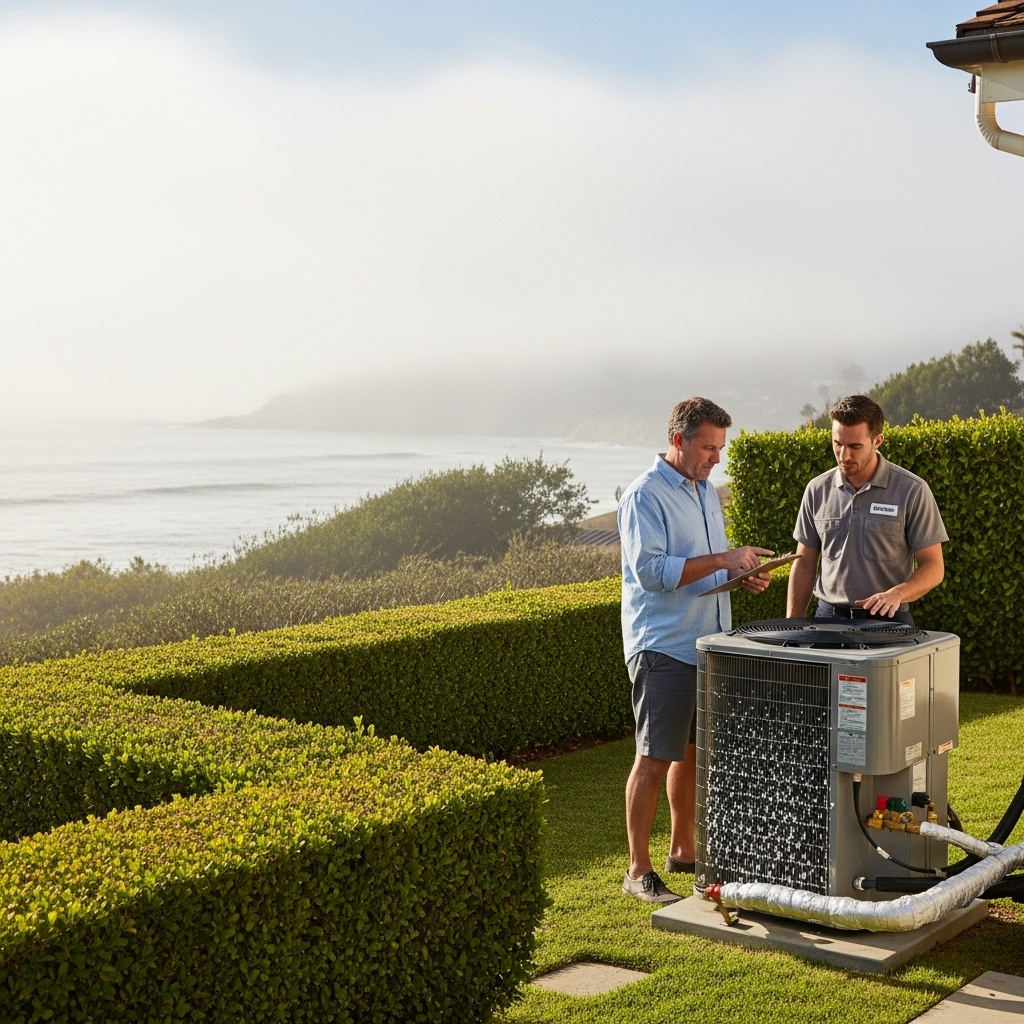Living in Malibu means enjoying ocean breezes, sun-soaked days, and mild winters—but it also means your air conditioning system faces unique coastal challenges like salt-laden air, fog, wildfire smoke, and seasonal heat waves. A thorough, easy-to-follow maintenance checklist tailored to Malibu conditions will help your AC operate efficiently, deliver cleaner indoor air, and stay reliable when you need it most. Use this comprehensive guide to plan routine tasks, document your work, and know when to bring in a professional. If you prefer a structured plan you can reference all year, the resource at keyword can complement everything outlined below.
Why a Malibu-Specific Maintenance Checklist Matters
Many AC checklists cover the basics, but Malibu’s coastal environment adds extra variables that can shorten equipment life and reduce performance. Salt air can accelerate corrosion on outdoor components. Coastal fog and marine layer moisture promote grime buildup. Seasonal Santa Ana winds can carry dust and debris into outdoor units and indoor filters alike. And wildfire smoke, while seasonal and unpredictable, can rapidly clog filters and irritate sensitive lungs. Creating a Malibu-specific maintenance routine addresses these risks while keeping comfort and energy use in balance.
A tailored checklist also helps you stay ahead of small issues. By breaking maintenance into monthly, seasonal, and annual tasks, you’ll catch loose electrical connections, clogged drains, or neglected filters before they hinder performance. When heat spikes arrive, you’ll be ready, and your AC won’t struggle under preventable strain.
Pre-Season Preparation Checklist
Complete this section before the first big warm-up of spring or early summer. If your system sat idle for months, these steps help it start the season strong.
- Clear the outdoor condenser area. Remove leaves, twigs, weeds, or windblown trash within a two-foot radius of the unit. Trim hedges and tall grasses so airflow isn’t blocked. In Malibu’s coastal air, open space around the unit helps disperse salt and moisture.
- Gently clean the condenser fins. After shutting off power at the disconnect, use a soft brush or light hose spray to remove grime from fins. Avoid pressure washers—too much force can bend fins and reduce heat exchange efficiency.
- Inspect the condenser fan and top grille. Look for cracked fan blades, loose screws, or nests. If you see damage, schedule a repair before the first heat wave to avoid mid-season breakdowns.
- Check the refrigerant lines. Confirm that insulation is intact on the suction line (the larger of the two). Replace any cracked or missing insulation to improve efficiency and prevent condensation drips.
- Examine the electrical disconnect and wiring. Look for signs of corrosion or loose connections. If anything seems questionable, stop and call a professional to avoid safety hazards.
- Confirm the air handler is clean. Dust around the indoor unit and ensure it has adequate clearance. Check the service panel fasteners to reduce vibration noises during operation.
- Replace or clean the air filter. If spring winds brought dust or pollen, start the cooling season with a fresh filter. Malibu homes near canyons or busy roads may benefit from a higher-MERV filter that still meets your system’s airflow requirements.
- Test your thermostat. Replace batteries if needed, verify the date and time, and program schedules that reflect your household’s spring and summer routines.
Monthly and Bi-Weekly To-Dos
Coastal exposure can turn a once-per-season task into a monthly habit. These quick checks take minutes and extend the life of your system.
- Filter check and replacement: Inspect monthly, replace as needed. If smoke or dust events occur, check bi-weekly until air quality improves.
- Outdoor unit glance: Ensure nothing is obstructing the unit. Wind gusts and yard work can shift items closer to the condenser than you realize.
- Thermostat review: Confirm your program still matches your schedule. Malibu’s comfortable evenings may allow for less cooling overnight.
- Listen for new noises: Rattles or squeals often signal loose fasteners, a failing blower motor bearing, or debris caught in the fan.
Quarterly Tasks for Coastal Longevity
Every three months, complete a deeper set of tasks designed for Malibu’s marine environment.
- Rinse the condenser coil. Use a gentle hose stream to rinse salt, dust, and grime from the coil. Avoid high pressure and do this only with power off.
- Inspect coil fins. If fins are bent, a fin comb can help straighten them for better airflow. Work slowly to prevent further deformation.
- Check the condensate drain. Algae or debris can clog the drain during foggy periods. Clear blockages so condensation flows freely and doesn’t cause water damage.
- Look for rust or corrosion. Salt air can affect screws, brackets, and cabinet edges. Light surface rust may be cleaned and treated with a corrosion-inhibiting spray recommended by your technician.
- Evaluate duct registers. Dust and pet hair collect quickly. Vacuum registers and ensure they remain open and unblocked to maintain balanced airflow.
Biannual Deep-Dive
Twice a year—once before peak summer and once after—conduct a longer inspection. This is also a good time to schedule a professional tune-up if you prefer hands-off care.
- Clean evaporator coil access panel area. While coil cleaning is best left to a pro, you can gently vacuum the cabinet area and ensure no obstructions impede service access.
- Verify blower cleanliness. If you see heavy dust on the blower wheel or housing, a professional cleaning will restore efficiency and reduce noise.
- Tighten accessible fasteners. Vibrations from normal operation and Santa Ana winds can loosen screws on cabinets and mounting brackets.
- Inspect ductwork where visible. Look for disconnected joints, kinked flexible ducts, and insulation gaps—especially in attics exposed to temperature swings.
- Reassess system settings. Verify fan settings, humidity targets (if applicable), and schedules based on current household patterns.
Annual Professional Maintenance Points
Even diligent homeowners benefit from a yearly professional service. Knowing what technicians typically perform helps you understand system health and spot issues early.
- System performance testing: Measuring supply and return air temperatures, static pressure, and refrigerant subcool/superheat.
- Electrical safety check: Inspecting contactors, capacitors, relays, and wiring integrity for heat or corrosion damage.
- Deep coil cleaning: Proper cleaning of evaporator and condenser coils without damaging fins or coatings.
- Condensate management: Clearing and treating drains to prevent algae buildup and water leaks.
- Blower assembly service: Cleaning the wheel and calibrating speeds if needed to match duct design and comfort goals.
- Duct inspection: Checking for leaks, crushed sections, and poor connections that waste cooled air and draw in attic dust.
Ask your technician to document findings. A record helps you plan future maintenance and supports warranty claims if parts fail prematurely.
Post-Storm or Heatwave Inspection
After high wind events, smoky days, or extreme heat, perform a quick visual inspection. Remove windblown debris, check filters for rapid clogging, and listen for abnormal startup or shutdown noises. Malibu’s microclimates can produce sudden shifts—responding quickly keeps your AC stable and efficient.
Indoor Air Quality Strategies for Malibu Homes
Indoor air quality matters year-round, but it becomes critical during wildfire smoke or heavy pollen. Focus on filtration, sealing, and sensible operation.
- Right-size filters: Choose a filter that balances airflow with particle capture. A too-restrictive filter can strain the blower, while a too-porous filter misses irritants.
- Seal penetrations: Attic and crawlspace leaks draw in dusty, hot air. Sealing reduces the burden on your AC and keeps indoor air fresher.
- Operate fan thoughtfully: Running the fan continuously can help circulate air through filters, but it may also draw in unconditioned air through leaks. Consider timed fan cycles during smoky periods.
- Room-by-room ventilation: Use bath and kitchen fans to exhaust moisture and odors, but avoid overuse when outdoor air quality is poor.
Energy-Savvy Thermostat Practices
Balancing comfort with energy use starts with intelligent thermostat strategies that reflect Malibu’s climate.
- Use setback schedules: Allow higher setpoints when away and slightly cooler temperatures when home. Overnight, open windows if marine layer air is comfortable and safe.
- Avoid extreme setpoints: Setting the thermostat too low won’t cool faster; it simply runs longer and may cause unnecessary wear.
- Leverage zoning if available: Direct cooling to occupied spaces and relax temperatures in rarely used rooms.
- Review settings seasonally: School schedules, travel, and coastal weather shifts all affect ideal programming.
Documenting Maintenance and Planning Ahead
Keep a simple log of the dates you changed filters, rinsed coils, or scheduled professional work. Note any unusual odors, noises, or performance changes. Over time, patterns emerge—like filters clogging faster during late-summer smoke or rattles returning after high winds—that guide smarter maintenance intervals. In the middle of the season, when you reassess settings and airflow, referring to resources such as keyword can help confirm you’re covering the essentials without over-servicing.
Safety Notes and When to Call a Pro
Always turn off power before opening access panels or rinsing outdoor coils. If you smell burning, notice frequent breaker trips, or see icing on refrigerant lines, stop and contact a qualified technician. Likewise, if ductwork needs repair in hard-to-reach areas, or if your evaporator coil requires cleaning, professional service is the safest route. Early attention prevents small problems from escalating into system failures during peak heat.
Frequently Asked Questions
How often should Malibu homeowners change AC filters? Coastal dust, pollen, and smoke can clog filters faster than inland areas. Check monthly and replace when visibly dirty or when airflow drops—often every one to three months depending on conditions and filter type.
Do I need to cover my outdoor unit near the ocean? Full covers can trap moisture and encourage corrosion. Instead, keep the area clear and rinse coils periodically. If you choose a top cover for off-season protection, ensure it’s breathable and remove it before operation.
What signs indicate salt corrosion? Look for rust on screws, cabinet edges, mounting brackets, and electrical contacts. Flaking metal or discolored surfaces signal the need for cleaning and preventative treatment.
How can I prepare for wildfire smoke events? Stock extra filters in advance, set your system to recirculate, and minimize outdoor air intake. Check filters more frequently and replace as soon as airflow drops or indoor air quality worsens.
Is coil cleaning a DIY task? Light rinsing of the outdoor coil is reasonable for many homeowners. However, deep cleaning of the indoor evaporator coil and chemical coil treatments are best left to professionals to avoid damage.
What temperature should I set in summer? Choose the highest indoor temperature that keeps your household comfortable. Combine ceiling fans, window coverings, and evening ventilation to reduce cooling demand without sacrificing comfort.
Putting It All Together
To keep your Malibu home comfortable and protected, use this checklist as a living document. Adjust frequencies based on your microclimate—beachfront, canyon-side, or hilltop homes each face different exposures—and keep notes that guide future decisions. With consistent attention to filters, coils, drains, and airflow, your AC will run more efficiently, last longer, and deliver cleaner air throughout the season.
Ready for Reliable Cooling in Malibu?
Your AC doesn’t need constant attention—just the right tasks at the right time. Whether you prefer to handle basics yourself or coordinate annual tune-ups, a clear plan keeps everything on track. For a practical, homeowner-friendly overview you can revisit as the season changes, check out keyword, then tailor the steps to your home’s unique conditions. With a consistent routine, you’ll be ready for the next heat wave, sea breeze, or foggy morning without worry.

